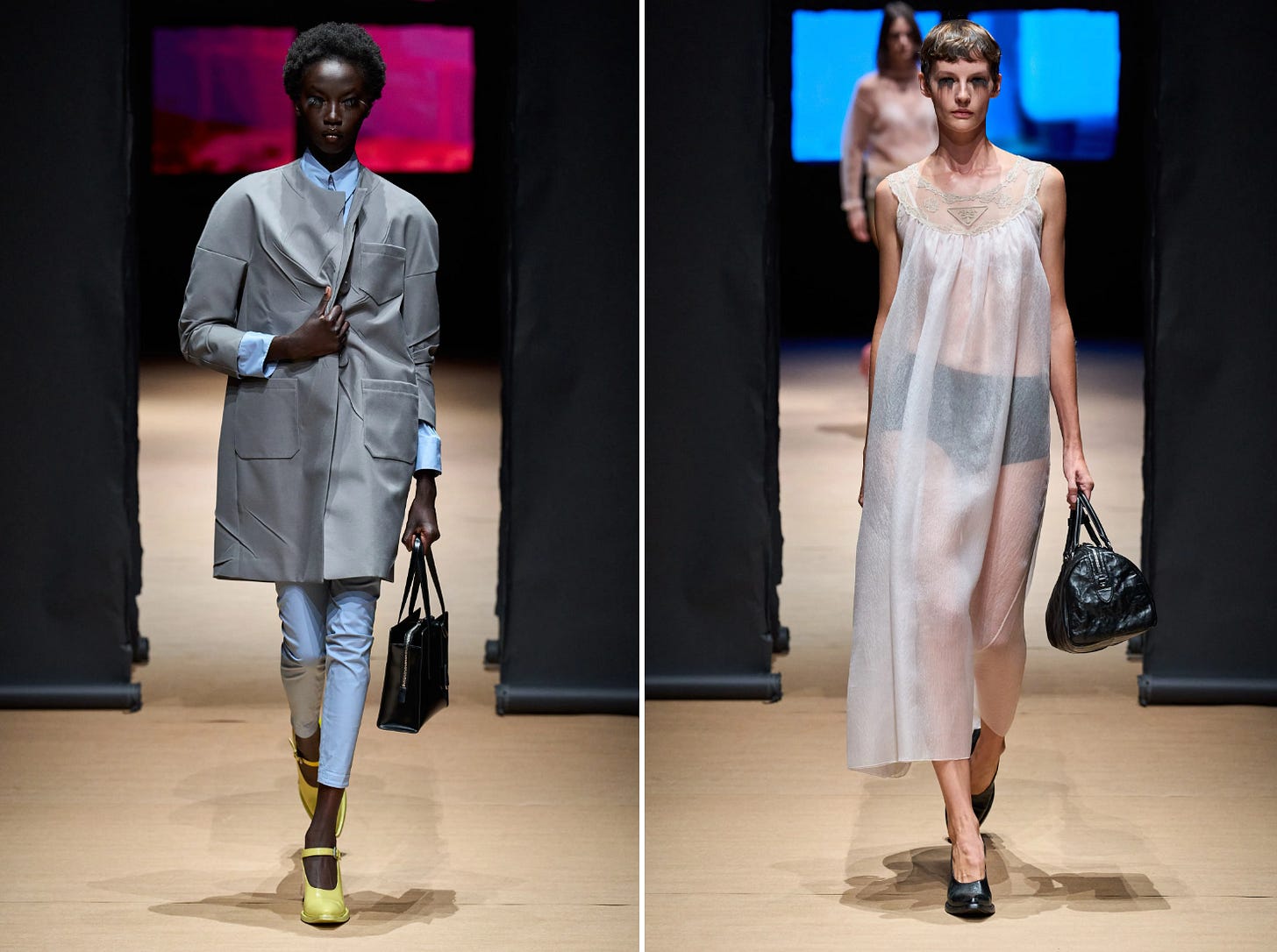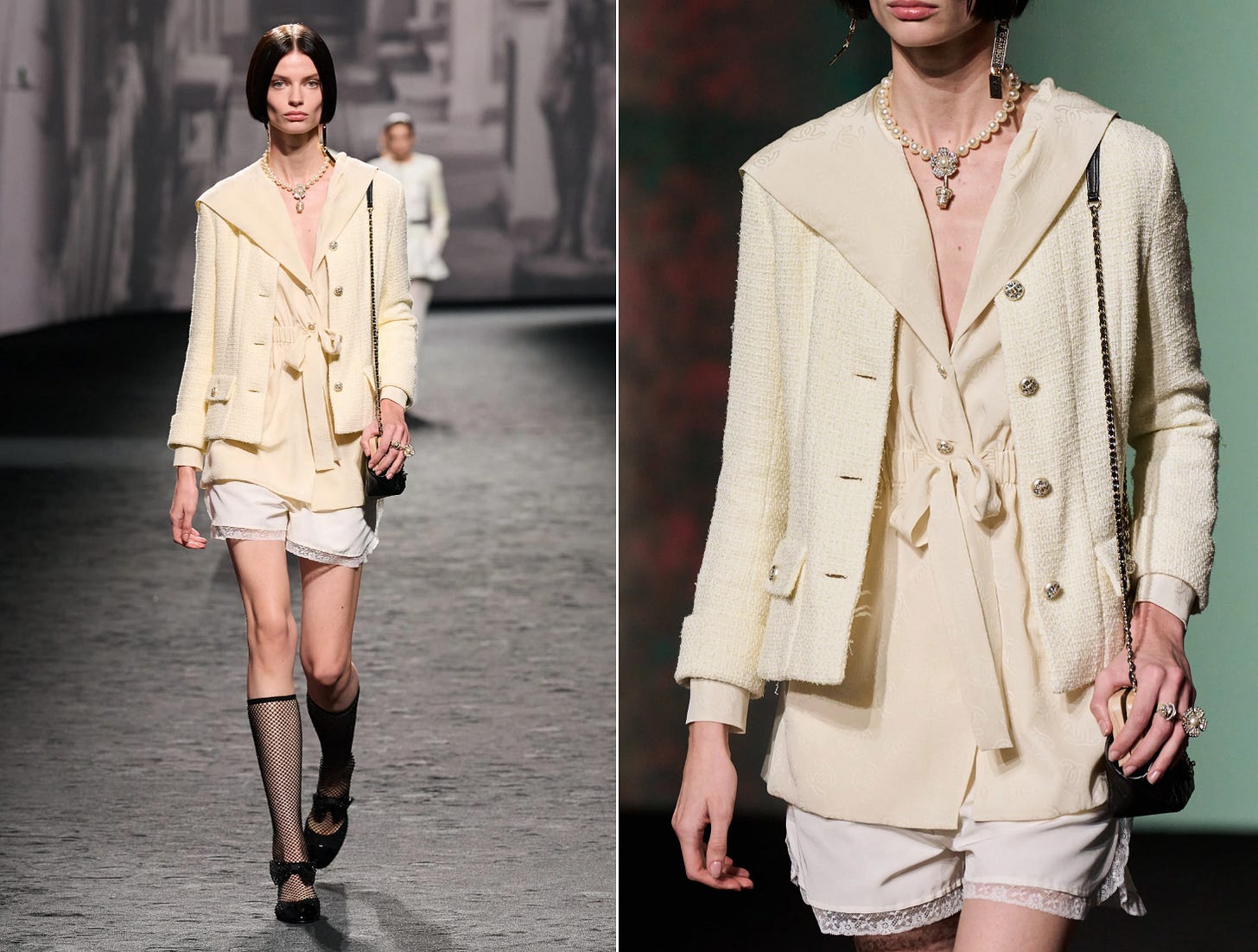Lingering thoughts on the heels of fashion month
Thoughts on Spring 2023
A few things coming together in my head on the heels of fashion month:
Paris seemed like it was booming, with enough escalating energy shooting through the screens that separated attendants from remote spectators that you could feel it and I think that’s because it’s the fashion city — like where an interest in the artistry of clothes and the upholding of couture as this like, cultural institution is central to the city’s raison d’etre. And now with life feeling mobile and expressive in a way it has not felt for some years or at least with a dedicated desire to zero in again on expression and beauty (possibly as a means of coping for some, or to find ground within instability), fashion feels more relevant than it has in a long time.
Which makes me think that the reason it has felt like such a dud or just out of touch on the runways for the three years that preceded this one is because there was, with reason, such a dearth of hope and inspiration, there was so much insecurity — this feeling almost like a moral obligation to not give oneself permission to pursue the beautiful, to find presence, but really to balance how unnecessary new clothes are when you have nowhere to go, or how stupid it makes you feel to still think about them or to want them when there is serious unrest elsewhere.
Maybe this is why Miuccia Prada’s work has been resonating with the mainstream even more potently than usual, why her collections didn’t lose touch — because she is the rare designer who is not afraid to convey what many know and what many who have dedicated their lives and livelihoods to their identities within fashion (whether formally or not) fear: that fashion is just a moment in its consumer’s day. It’s not nothing, but it’s not everything. Perhaps understanding this is the difference between a designer’s ability to create honestly and passionately and one’s feeling the need to make their clothes seem like more (or less) than they really are.
That or, the archives are so phenomenally rich and also readily available thanks to the explosion of resale in prior years.
But I get the sense that consignment consumption is going to slow down. While its impact on the environment is no doubt more positive than the acquisition of new, part of the reason, I think, consignment shopping became such a thing is because so few new ideas were born into fashion over the pandemic. It’s like, we desired what fashion has always given us, right? A new idea to match the internal experience of how life progresses, but we were stalled, we were stuck. There was no progress, which didn’t extinguish the inclination to seek, it’s just that where one used to look now had little to offer, so the pursuit targets started to change.
With no new churn out that was meaningful enough to rev up the engine, it was back to the archives. You know?
This theory is flawed, because fashion is so cyclical, but I do think there is something to shopper behavior, where they go for what they want and how that is impacted by the new clothes on display.
Per the cyclical thing, btw, look no further than the deluge of platforms (as in shoes, not social networks) that were on runways this season.
Amy Odell analyzed the trend yday in her newsletter, The Back Row, just while I had been thinking that the lace-like negligee shorts shown at Chanel remind me how I dressed (or more accurately wanted to dress) in like, 2008.
And speaking of Chanel, when I was looking at the new collection after it aired on Tuesday, I kept thinking about how it is even possible that without contributing very much to the popular culture of fashion (in the way that say, Loewe or Balenciaga do), it remains so culturally relevant. Grounded in modernity.
I say this as a self-professed super fan, so take it with a grain of salt, but there is no brand like it — from the clever strategy that seems to underpin who the house brings on as ambassadors, well-known and revered widely (see: Kristen Stewart) or within a chosen niche (like Laila Gohar), to the sense of scarcity the brand has been able to produce without compromising on sellability (any consumer of luxury will find something that will make them feel special, but these findings exist on different planes, from the very simple [a classic 2.55] to the extremely rare [a runway jacket that was only produced in an edition of 3].)
I loved Tuesday’s collection. Even through a screen, it was such a clear representation of how the brand can read traditional and new in the same breath. There’s a formula that’s hard to break down, even though its feeling is palpable — a relentlessness about the preservation of glamour, almost as if it’s a divine feminine right. And the more diverse range of body types really added to its tender appeal.
Now I’m going out of order, but the final line item here is on Miu Miu, who has been on my mind a lot since I read Rachel Tashjian’s piece on Mrs. Prada for Harper’s Bazaar last month. (Actually, all of her writing for the season has been an extremely satisfying amalgam of three components that I believe make fashion writing worth reading in their combination of observation, theory, and cultural anchoring.) I think these clothes do a similar thing per my last note on Chanel in that they are also relentless about their preservation of glamour.
Almost like it’s an expression of rebellion. It’s a different glamour, one that can seem more mobile or something — like you can breathe it in visually and exhale your own rendering; as much about the styling as it is about the individual garments. But comparing Chanel to Miu Miu is a fool’s errand, the brands do their thing so differently. If two seasons ago was like cat nip for internet dressers with the hacked sweaters and tiny-ass skirts and last season was its continuation with the introduction of those ballet flats which now that I think of it may have become the wind beneath the wings of le season de Soft Mary Janes, this one read more like an intermission, a deliberate arm of restraint or moderation to keep in healthful pace the unfolding onion that is Mrs. Prada’s mind.
It’s the first time in a long time that I’m exploding with thoughts on new clothes — what they do, what they say, but really what they mean. It feels familiar but new and natural but still distant. I’m on for the ride, so here’s to that — the beginning of what seems like a return to finding depth in the not nothing, not everything-ness of fashion.










Leandra, Thank you. I really enjoy your point of view, especially these little mindful moments. I struggle with my love for clothing. I'm more into clothes themselves than I am into "fashion", you know what I mean? (Of course you do). The struggle is - why am always thinking about clothes when there are so many other things to think about and care about? It makes me feel shallow. For the record, I am not shallow, but there is a voice that says loving clothes as much as I do is wrong. And then you remind me that we experience beauty in our own ways. Art is personal. Creative expression is very personal and for some of us it's a way we not only communicate, but also how we show up. Like, "See, I'm here" - which can lead to also showing up in other ways too, ones that matter beyond just being dressed well or interestingly. Anyhoo, just wanted to say thanks for doing what you do. I love The Cereal Aisle! :)
I’m so interested that you feel like that about Chanel - I love their enduring classics (jacket, bag, pump) but I don’t find it remotely culturally relevant/ curious/ responsive. Interested why you feel it is?